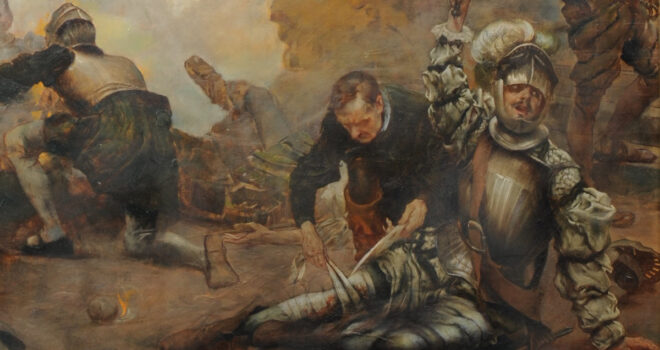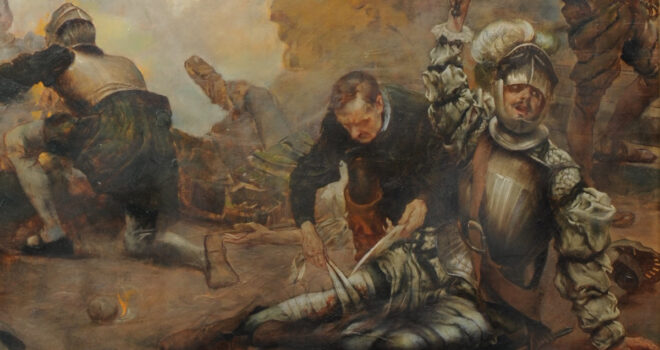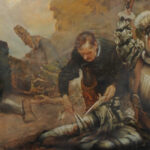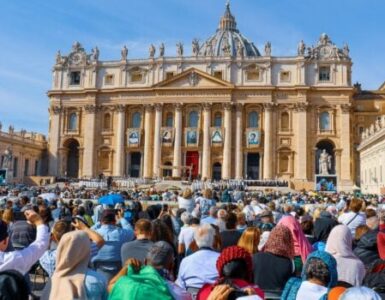One of the most dramatic episodes in Church history occurred on May 20, 1521 at the Battle of Pamplona, where St. Ignatius Loyola, founder of the Society of Jesus, was wounded by a cannon ball that would alter the trajectory of his life. Today, on the feast of this notable saint, we will learn a bit about the circumstances of this life-changing event and use it as an occasion to contemplate the mysterious workings of God’s providence.
Pamplona was the seat of the ancient Basque Kingdom of Navarre, straddling the Pyrenees between Spain and France. In olden times Navarre had been independent of both kingdoms, though it had enjoyed a long affinity with France, which it had used as a bulwark against the expansionist aims of the kings of Aragon and Castile. But in 1512, King Ferdinand of Aragon dispossessed the last Navarrese king and claimed the territory for Spain. Ferdinand’s subjugation of Navarre was harsh; he demolished most of the smaller Navarrese fortifications and staffed the bigger ones with his own garrisons. The Navarrese towns were forced to accept Spanish institutions—and Spanish taxes. The young Ignatius of Loyola, in the service of his kinsman Don Antonio Manrique, Duke of Najera, was among one of the Spaniards sent north as occupiers to pacify Navarre for the King of Spain.
But when Ferdinand died in 1516, he was succeeded by the young Hapsburg heir Charles. The accession of a new monarch was always a period for jostling and negotiation, and the cities of Navarre attempted to negotiate with the young king for the restoration of some of their ancient liberties. Charles, however, refused, compounding the resentment among the hardy Basques. This frustration would simmer until exploding in 1521 under the following circumstances into which our hero, St. Ignatius, found himself swept up:
When Charles departed Spain for Germany in 1519 to become Holy Roman Emperor, he left Spain under the control of his Viceroy, Cardinal Ximenès. With Charles gone, his rival King Francis I of France launched an invasion of Spain. The Navarrese, fed up with the exactions of the Spaniards, eagerly rose in rebellion, promising to aid France’s war efforts in exchange for the restoration of their ancient privileges. The Franco-Navarrese army swarmed over the countryside in spring of 1521, driving the Spaniards before them, who were unprepared for the sudden violence. Messengers dashed off to Cardinal Ximenès pleading for reinforcements, but it would be some time until any could be mustered.
St. Ignatius was at this time serving in the garrison of Pamplona, the capital of Navarre and its most heavily fortified city. We are not certain how he came to be in Pamplona; some authors say he was stationed there when the war broke out, others came to reinforce the city at the attacks of the French. We do know that in late May of 1521 we see him in the service of the Commandant of the city, working to fortify the place against the inevitable French onslaught. The arrival of the French army caused consternation among the Spaniards, who were outgunned and outnumbered. The Commandant suggested surrendering, but Ignatius insisted that they hold out, believing they could withstand a siege until the arrival of Cardinal Ximenès’s reinforcements.
The situation became more dire when the French quickly occupied the town with no opposition, as most of the Navarrese townsmen went over to the invaders’ side. Ignatius found himself barricaded in the city’s citadel with only a few defenders. Even in Ignatius’s day this citadel was a crumbling rampart built upon one of the Pamplona’s many precipices, hardly suitable to withstand a cannonade. The French perhaps felt bad for the beleaguered defenders, as they allowed Pamplona’s Commandant an opportunity to parley and negotiate terms of surrender. The Commandant chose St. Ignatius to join him in the meeting, and the group went out to visit the quarters of the French general. The French were inclined to let the defenders go, but not without humiliating them by insisting on various obeisances and submissions intended to wound the Spaniards’ pride. Again, the Commandant would have accepted surrender, but Ignatius, stirred by national pride and chivalric zeal, vehemently rejected the French terms, and encouraged the Spaniards to hold out for Ximenès. Reluctantly, the Commandant heeded Ignatius’s advice and spurned the French offer.
The French thought the Spaniards mad for choosing to fight in such a clearly unequal match and were indignant at having to waste time besieging a town destined to fall anyway. They resolved to punish the Spaniards for their intransigence and planned an especially brutal attack on the citadel for the following day, May 20. Ignatius, who had for all intents and purposes assumed control of the defenses of the citadel in place of the terrified Commandant, did his best to organize the few Spaniards in the garrison and reinforce the tottering walls where he could, meanwhile praying that Ximenès arrived before sunrise. In a practice common at the time when no priest was on hand, Ignatius confessed his sins to a fellow soldier, an act of penance and confidence in the mercy of God.
On the morning of May 20, the French opened the siege of Pamplona with a brutal cannon barrage intended to make quick work of the citadel’s defenses. The bombardment lasted for six grueling hours. At age 29, Ignatius had already taken part in several battles, but certainly nothing of this caliber. Nevertheless, he carried himself honorably, dashing to and fro atop the battlements to direct the fire of his men, reinforce a gap in the line, or urge his comrades on with his indomitable zeal.
The courage of Ignatius was no match for the French cannonade, however, and he was struck by a cannon ball which ricocheted off a wall. The cannonball shattered the bones in his right leg and left a gaping flesh wound in his left. The walls were soon breached, and the citadel fell to the French. Though they had intended to make an example of the Spanish defenders, the French were moved to pity at the sight of the bold young Ignatius, his body broken and writhing in pain upon the flagstone of the citadel. They took the brave Spaniard into their care and transferred him to their quarters, where he was attended by French doctors for two weeks before being sent home to his family castle at Loyola for a long convalescence.
We know how this story ends—during his long recuperation, Ignatius began reading the lives of the saints and was inspired to contend for the kingdom of heaven instead of for worldly glory. He would spend years in study and solitude, eventually formulating the Spiritual Exercises that would constitute the core of Ignatian spirituality. In 1540, nineteen years after the cannonball ended his military career, Ignatius would found the Society of Jesus (Jesuits), a company of men dedicated to a wholly spiritual kind of combat. The Jesuits in turn would, through their missionary work, bring the Gospel to the far flung corners of the globe, from the jungles of Paraguay to the shores of Japan to the forests of Quebec. Through their educational institutions they set the standard of Catholic education in Europe from the 16th to 18th centuries. St. Ignatius’s order was undoubtedly one of the most potent forces in global Catholicism during the post-Reformation era.
In reviewing the story of St. Ignatius’s wounding, we cannot but marvel at the providence of God. From a merely human perspective, the events that unfolded before the walls of Pamplona in May 1521 were due to a hodge-podge of coalescing sociopolitical factors: royal ambition, ancient national rivalries, matters of taxation and autonomy, ethnic pride, the circumstance of an absent ruler; the ball that crippled Ignatius was fired by an unknown soldier and struck his leg by what appears to have been an accident of geometry. And yet, the providence of God was working through all of these elements to birth one of the Church’s greatest saints and the emergence of a vibrant new order that would bring countless thousands of souls to Christ.
Our own stories may be nowhere near as dramatic as St. Ignatius’s, but the principle is the same: God’s providence unfolds through secondary causes—through the free decisions we make, through the dispositions we carry, through the socioeconomic factors affecting our lives, even through the disasters that sometimes afflict us. Providence is not something outside of our experience; it is our experience. It is the way God utilizes the free decisions of everybody to bring about His will. Just as Ignatius grappled with finding God’s will as he lay crippled in convalescence during the summer of 1521, so we, too, must look for the will of God in the depths of our own circumstance.










